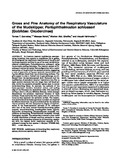Gross and fine anatomy of the respiratory vasculature of the mudskipper, Periophthalmodon schlosseri (Gobiidae: Oxudercinae)
- Global styles
- MLA
- Vancouver
- Elsevier - Harvard
- APA
- Help

View/
Date
2011Page views
1,826ASFA keyword
Metadata
Perlihat publikasi penuhCited times in Scopus
Share
Abstract
To illustrate vascular modification accompanying transition from aquatic to amphibious life in gobies, we investigated the respiratory vasculatures of the gills and the bucco-opercular cavities in one of the most terrestrially-adapted mudskippers, Periophthalmodon schlosseri, using the corrosion casting technique. The vascular system of Pn. schlosseri retains the typical fish configuration with a serial connection of the gills and the systemic circuits, suggesting a lack of separation of O2-poor systemic venous blood and O2-rich effluent blood from the air-breathing surfaces. The gills appear to play a limited role in gas exchange, as evidenced from the sparsely-spaced short filaments and the modification of secondary lamellar vasculature into five to eight parallel channels that are larger than red blood cell size, unlike the extensive sinusoidal system seen in purely water-breathing fishes. In contrast, the epithelia of the bucco-opercular chamber, branchial arches, and leading edge of the filaments are extensively laden with capillaries having a short (<10 μm) diffusion distance, which strongly demonstrate the principal respiratory function of these surfaces. These capillaries form spiral coils of three to five turns as they approach the epithelial surface. The respiratory capillaries of the bucco-opercular chamber are supplied by efferent blood from the gills and drained by the systemic venous pathway. We also compared the degree of capillarization in the bucco-opercular epithelia of Pn. schlosseri with that of the three related intertidal-burrowing gobies (aquatic, non-air-breathing Acanthogobius hasta; aquatic, facultative air-breathing Odontamblyopus lacepedii; amphibious air-breathing Periophthalmus modestus) through histological analysis. The comparison revealed a clear trend of wider distribution of denser capillary networks in these epithelia with increasing reliance on air breathing, consistent with the highest aerial respiratory capacity of Pn. schlosseri among the four species.
Suggested Citation
Gonzales, T. T., Katoh, M., Ghaffar, M. A., & Ishimatsu, A. (2011). Gross and fine anatomy of the respiratory vasculature of the mudskipper, Periophthalmodon schlosseri (Gobiidae: Oxudercinae). Journal of Morphology , 272(5), 629-640. https://doi.org/10.1002/jmor.10944
Type
ArticleISSN
0362-2525Koleksi
- Journal Articles [1229]

